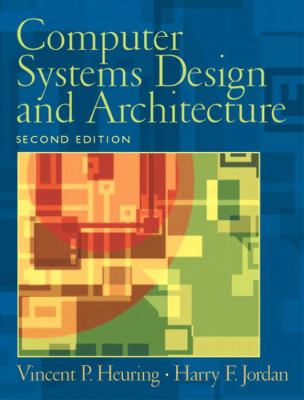162246
9780130484406
Computer Systems Design and Architecture (2nd Edition)
by Harry F. Jordan, Vincent P. Heuring
About this item
- Condition: New
- Provider: gridfreed
- Provider Rating: 68%
- Ships From: San Diego, CA
- Shipping: Standard
- Comments: New. In shrink wrap. Looks like an interesting title!

About this item
- Condition: Good
- Provider: IndianaBookCompany
- Provider Rating: 89%
- Ships From: Marion, IN
- Shipping: Standard, Expedited
- Comments: Ships same or next business day with delivery confirmation. Good condition. May or may not contain highlighting. Expedited shipping available.

About this item
- Condition: Very Good
- Provider: GoTextbooks
- Provider Rating: 78%
- Ships From: Little Rock, AR
- Shipping: Standard

Product details
- ISBN-13: 9780130484406
- ISBN: 0130484407
- Edition: 2
- Publication Date: 2003
- Publisher: Prentice Hall
AUTHOR
SUMMARY
To the Instructor This book is suitable for an introductory course on computer design at the junior, senior, or introductory graduate level. We assume that the student has had at least an introductory course in some high-level programming language such as C or Pascal, and a semester of logic design. However, a comprehensive appendix on digital logic design, written by Professor Miles Murdocca of the Internet Institute USA, provides sufficient background material for teaching the course to students without previous digital design experience. Appropriate topics for such a book have changed considerably in recent years, as desktop computers have evolved from simple, stand-alone units into complex systems attached to high-speed networks and internetworks. Earlier generations of microprocessors had almost trivial internal structure Present designs contain multiple pipelined functional units with support for multiple processors and memories. Areas of computer design and architecture that were barely touched upon in the not-so-distant past have become major topics for discussion. Introductory compiler courses now routinely discuss optimization for pipelined processors. Users worry about whether they should add level-2 cache memory to their PCs. Support personnel wearily try to explain to the computer user how to configure the subnet mask for their network slip connection. The topics of pipelined processor design, the memory hierarchy, and networks and internetworking are moving to center stage in the arena of computer design and architecture. Therefore we devoted the major parts of three chapters to treatment of these subjects. Given the focus on computer design and computer architecture, we approach the study of the computer from three viewpoints: the view of the assembly/machine language programmer, the view of the logic designer, and the view of the system architect. In covering the topic of gate-level computer design, we follow a model architecture through the design process, from the instruction set design level to the processor design level. Given the choice of using either a commercial machine with all of the complicating features that are necessary to make such a machine commercially successful, or using a model design that introduces enough practical features to make it both interesting and relevant to the subject, we chose the latter. The model machine, Simple RISC Computer (SRC), is a 32-bit machine with an instruction set architecture that is similar to, but simpler than the current generation of RISC's. We adopt the view that it is best to use a formal description language in describing machine structure and function. There are many languages from which to choose. We selected a variant of the ISP language, Register Transfer Notation (RTN). We chose this from many alternatives, because most of the languages used by practitioners are aimed more at hardware description and less at machine behavior and function. RTN is simple, easy to learn, and is at the appropriate description level. To the Student The computer ushers us into the information age. Born a mere fifty years ago, it now exerts a profound influence on almost every facet of our lives. What is the nature of this machine? How does it work inside? How is it programmed internally? What is the nature of each of its connections to the outside world? These are the questions that this book will help you answer, and we hope that when you have mastered it you will be left with no mysteries about how computers work. We feel that one of the best ways to learn how a computer works is to design one, so throughout most of the book we have taken the perspective of the designer rather than that of the observer or the critic. Computers are arguably the most complex systems humankind has ever built, and like all complex systems they can be appreciated from many viewpoints. A building can be examined for its overall archiHarry F. Jordan is the author of 'Computer Systems Design and Architecture (2nd Edition)', published 2003 under ISBN 9780130484406 and ISBN 0130484407.
[read more]


